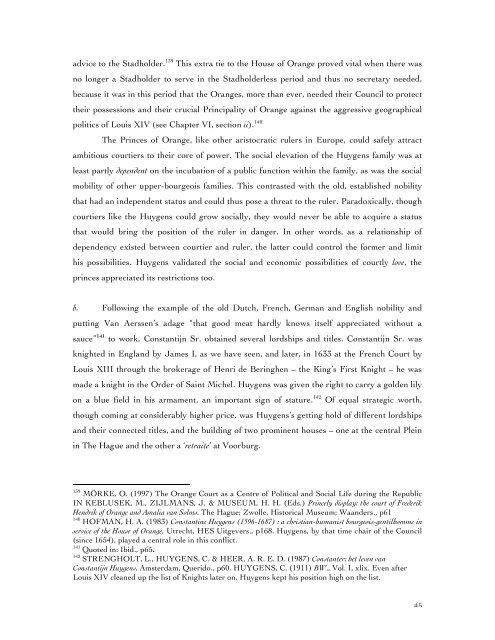Christiaan Huygens – A family affair - Proeven van Vroeger
Christiaan Huygens – A family affair - Proeven van Vroeger
Christiaan Huygens – A family affair - Proeven van Vroeger
You also want an ePaper? Increase the reach of your titles
YUMPU automatically turns print PDFs into web optimized ePapers that Google loves.
advice to the Stadholder. 139 This extra tie to the House of Orange proved vital when there was<br />
no longer a Stadholder to serve in the Stadholderless period and thus no secretary needed,<br />
because it was in this period that the Oranges, more than ever, needed their Council to protect<br />
their possessions and their crucial Principality of Orange against the aggressive geographical<br />
politics of Louis XIV (see Chapter VI, section ii). 140<br />
The Princes of Orange, like other aristocratic rulers in Europe, could safely attract<br />
ambitious courtiers to their core of power. The social elevation of the <strong>Huygens</strong> <strong>family</strong> was at<br />
least partly dependent on the incubation of a public function within the <strong>family</strong>, as was the social<br />
mobility of other upper-bourgeois families. This contrasted with the old, established nobility<br />
that had an independent status and could thus pose a threat to the ruler. Paradoxically, though<br />
courtiers like the <strong>Huygens</strong> could grow socially, they would never be able to acquire a status<br />
that would bring the position of the ruler in danger. In other words, as a relationship of<br />
dependency existed between courtier and ruler, the latter could control the former and limit<br />
his possibilities. <strong>Huygens</strong> validated the social and economic possibilities of courtly love, the<br />
princes appreciated its restrictions too.<br />
b. Following the example of the old Dutch, French, German and English nobility and<br />
putting Van Aerssen’s adage “that good meat hardly knows itself appreciated without a<br />
sauce” 141 to work, Constantijn Sr. obtained several lordships and titles. Constantijn Sr. was<br />
knighted in England by James I, as we have seen, and later, in 1633 at the French Court by<br />
Louis XIII through the brokerage of Henri de Beringhen <strong>–</strong> the King’s First Knight <strong>–</strong> he was<br />
made a knight in the Order of Saint Michel. <strong>Huygens</strong> was given the right to carry a golden lily<br />
on a blue field in his armament, an important sign of stature. 142 Of equal strategic worth,<br />
though coming at considerably higher price, was <strong>Huygens</strong>’s getting hold of different lordships<br />
and their connected titles, and the building of two prominent houses <strong>–</strong> one at the central Plein<br />
in The Hague and the other a ‘retraite’ at Voorburg.<br />
139 MÖRKE, O. (1997) The Orange Court as a Centre of Political and Social Life during the Republic<br />
IN KEBLUSEK, M., ZIJLMANS, J. & MUSEUM, H. H. (Eds.) Princely display: the court of Frederik<br />
Hendrik of Orange and Amalia <strong>van</strong> Solms. The Hague; Zwolle, Historical Museum; Waanders., p61<br />
140 HOFMAN, H. A. (1983) Constantine <strong>Huygens</strong> (1596-1687) : a christian-humanist bourgeois-gentilhomme in<br />
service of the House of Orange, Utrecht, HES Uitgevers., p168. <strong>Huygens</strong>, by that time chair of the Council<br />
(since 1654), played a central role in this conflict.<br />
141 Quoted in: Ibid., p65.<br />
142 STRENGHOLT, L., HUYGENS, C. & HEER, A. R. E. D. (1987) Constanter: het leven <strong>van</strong><br />
Constantijn <strong>Huygens</strong>, Amsterdam, Querido., p60. HUYGENS, C. (1911) BW., Vol. I, xlix. Even after<br />
Louis XIV cleaned up the list of Knights later on, <strong>Huygens</strong> kept his position high on the list.<br />
45


